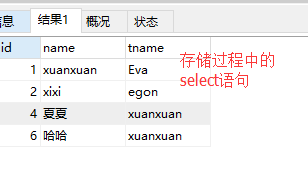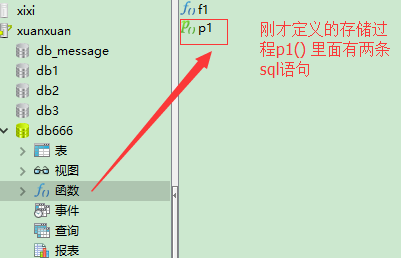1. 存储过程
存储过程也是一个别名,是保存在mysql中的一大堆sql语句所起的别名,日后可以直接不用在终端或者python中写sql语句 而是直接使用别名就可以拿到sql语句的执行结果;
对比视图来看,视图是用来保存查询结果的一张临时表,是虚拟的表,不可以插入,只可以查询操作;
而在存储过程中只需要写一个别名就可以自动去执行存储过程中的sql语句;
所以试图就是别名代指的临时表,而存储过程就是用别名代指很多sql语句的操作;
python中操作mysql数据库的三种方式:
1. mysql中什么也不做,程序中写sql语句;
2. mysql中什么也不做,程序来写类和对象(当然内部也会转化sql语句去执行);
3. mysql 中写存储过程,程序直接调用存储过程的名称来执行存储过程中的sql语句;
2. 简单存储过程
在mysql终端:
扫描二维码关注公众号,回复:
4157662 查看本文章


delimiter \\ create procedure p1() begin select * from student; -- 存储过程中可以写很多sql语句; insert into teacher(name) values("李丹"); end\\ delimiter ; call p1(); -- 在mysql的终端直接使用call p1() 调用存储过程,会自动执行存储过程中的sql语句;
运行结果:


在pymysql中执行存储过程:
import pymysql conn=pymysql.connect(host="localhost",user="root",password="******",database="db666",charset="utf8") #charset="utf8" 是为了存储过程返回的结果集有中文时 不乱码 cursor=conn.cursor(cursor=pymysql.cursors.DictCursor) # 参数是为了当查询结果按照字典形式显示; cursor.callproc("p1") # 调用存储过程,执行存储过程中的sql语句(以前都是cursor.execute(sql,[arg1,arg2])) conn.commit() # 存储过程的sql语句有增删改操作时需要把修改操作提交 result=cursor.fetchall() # 存储过程的sql语句有select查询语句 需要拿到查询结果集使用cursor.fetchall()获取; print(result) cursor.close() conn.close()
运行结果:
3. 存储过程带参数--in(参数三种方式 in out inout)
delimiter \\ create procedure p2( in n1 int, in n2 int) begin select * from student where id>n1; insert into teacher(name) values("尺子"); end\\ delimiter ; call p2(4,2) -- 直接传参数,这里第二个参数n2没有用到,但是也是需要传;
运行结果:
import pymysql conn=pymysql.connect(host="localhost",user="root",password="******",database="db666",charset="utf8") cursor=conn.cursor(cursor=pymysql.cursors.DictCursor) cursor.callproc("p2",(4,2)) # 调用存储过程,p2有参数 在cursor.callproc("p2",[arg1,arg2])传入参数; conn.commit() # 存储过程中有增删改操作时,需要进行提交 result=cursor.fetchall() # 存储过程中有查询操作 可以使用cursor.fetchall()获取结果集 print(result) cursor.close() conn.close()
运行结果:

4. 存储过程带参数---out
delimiter \\ create procedure p3( in n1 int, out n2 int) -- 存储过程中的out类型的参数,在后续调用存储过程传参数时需要传一个变量 begin set n2=666; select * from teacher where id>n1; end\\ delimiter ; set @v1=0; -- 设置存储过程中out类型的变量n1 初始值为0; call p3(4,@v1); select @v1; -- 查看out类型的变量 在经过存储过程set n2=666之后修改过的值 drop procedure p3; -- 删除存储过程p3;
运行结果:


import pymysql conn=pymysql.connect(host="localhost",user="root",password="123",database="db666",charset="utf8") cursor=conn.cursor(cursor=pymysql.cursors.DictCursor) cursor.callproc("p3",(4,12)) # 调用存储过程,传参数 但是由于存储过程的参数n1是out类型,所以后续可以使用cursor.execute("select @_p3_0,@_p3_1")来获取参数的返回结果 conn.commit() # 当存储过程中的sql语句含有增删改操作时,需要提交 result=cursor.fetchall() # 存储过程的sql语句含有select查操作时 需要获取查询结果集,可以使用cursor.fetchall() print(result) cursor.execute("select @_p3_0,@_p3_1") result=cursor.fetchall() # 上面的cursor.execute("select @_p3_1") 可以获得存储过程中参数的值 print(result) cursor.close() conn.close()
运行结果:

自定义函数有return 但是不可以select ,存储过程可以select 但是不可以return 但是自定义函数和存储过程都可以传参~
其实out 可以用于表示存储过程的执行结果(比如存储过程中的sql语句没有select需要返回结果集的 而是一些insert update delete 操作 那在终端调用存储过程是没有任何反应的,所以可以传一个out类型的参数标志存储过程的执行过程~)